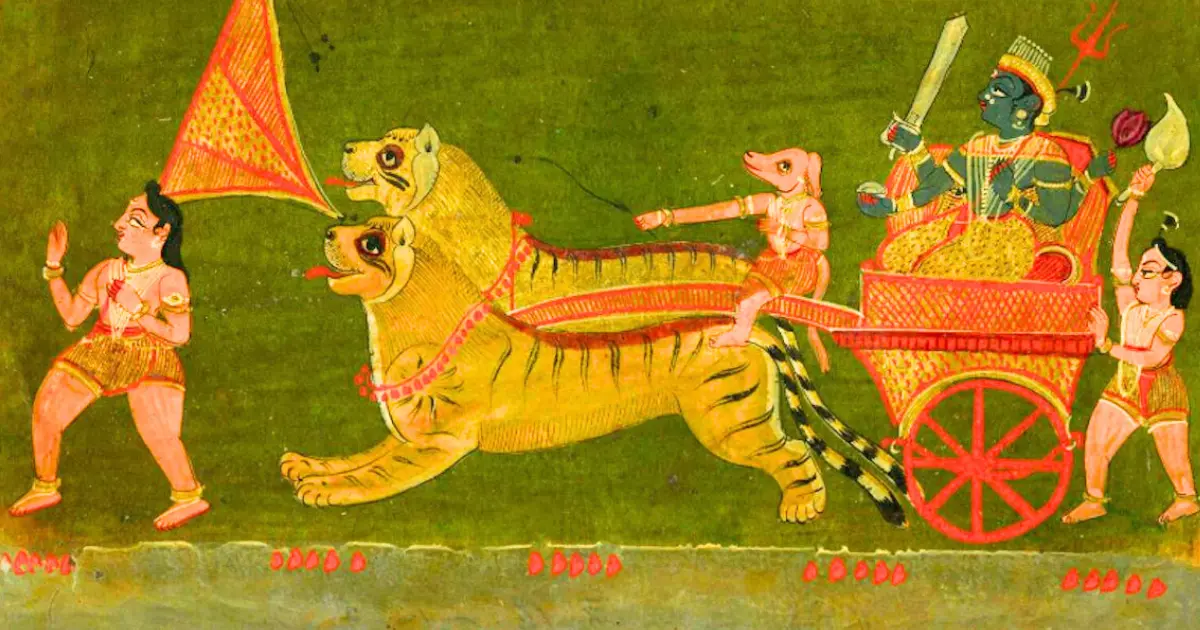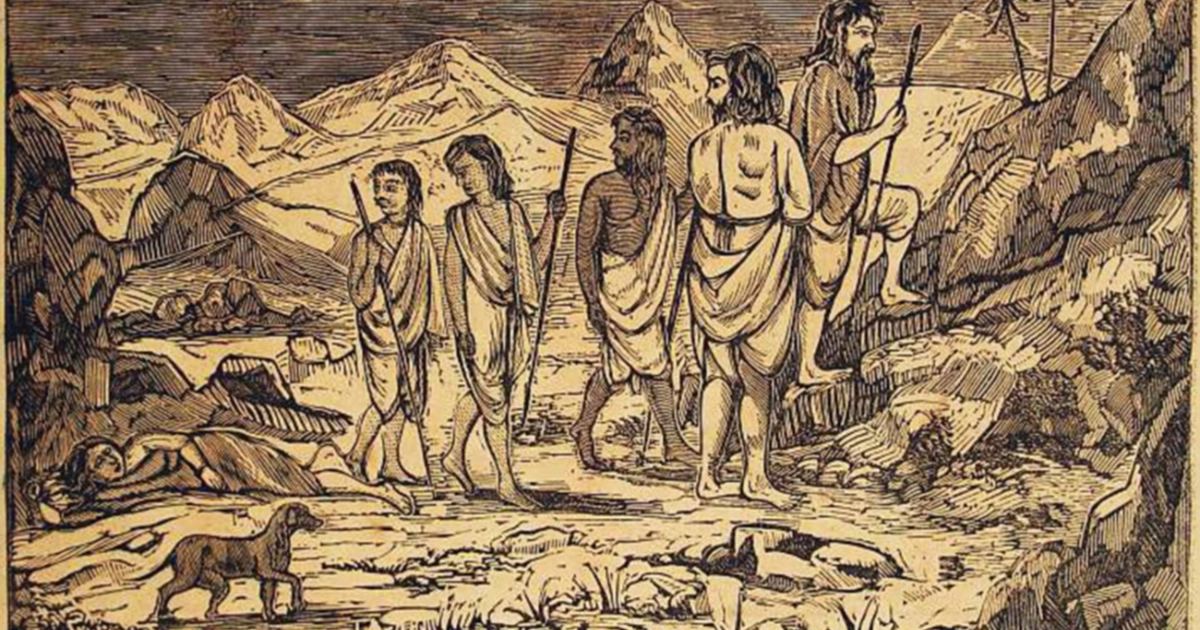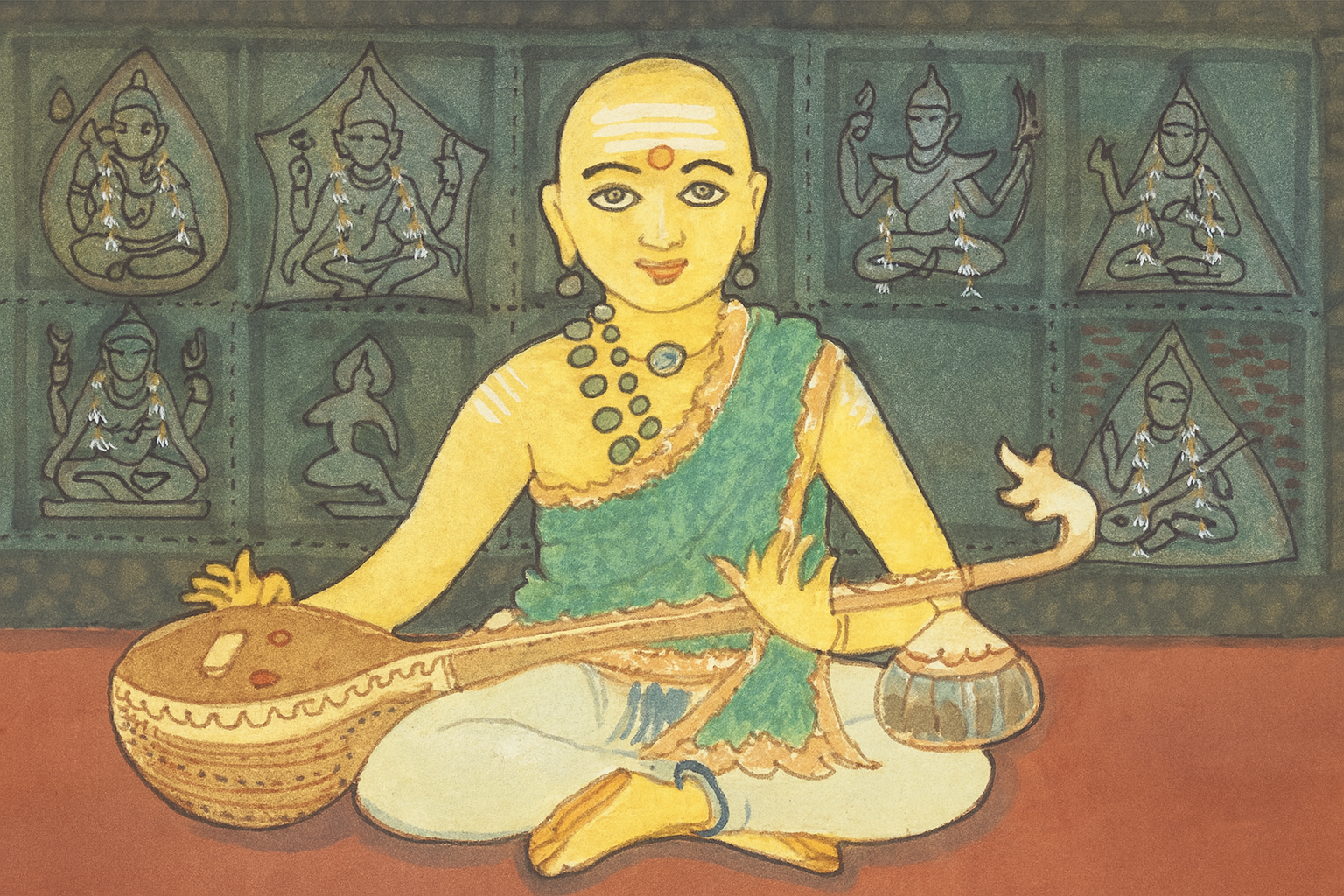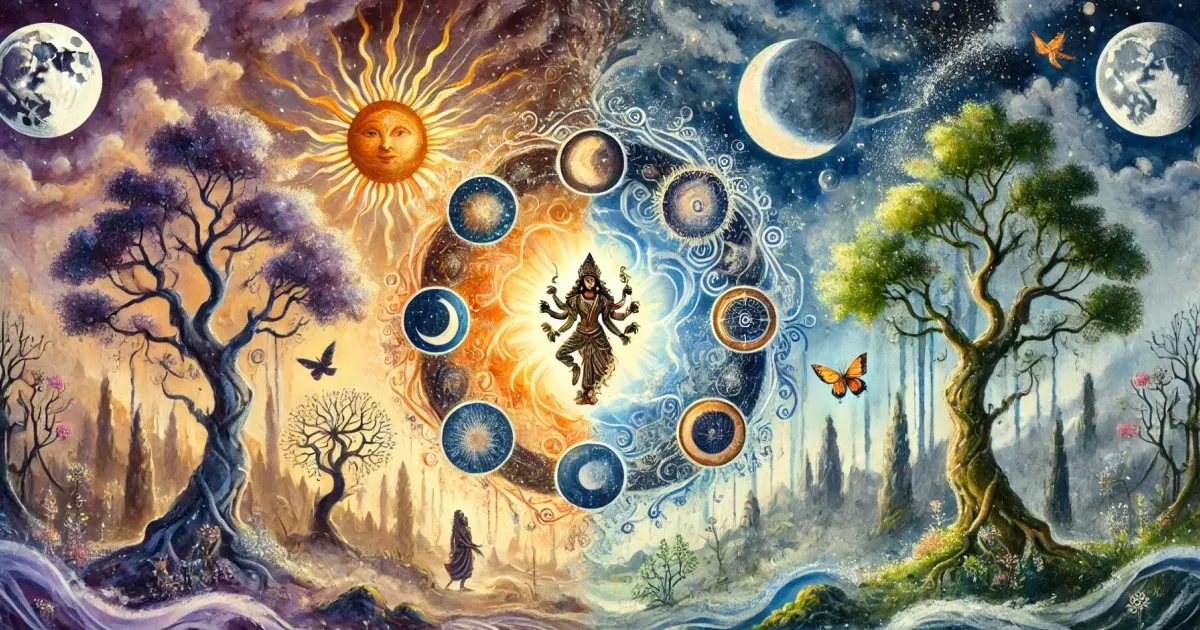Introduction
Śākta traditions wherein Devi or Goddess is worshipped as the primary power is an ancient religious stream that originated in the immeasurable antiquity of the ancient Indian spiritual thought. This stream too, like the religious milieu it originated in, does not yield easy answers for the scholarly pursuits that attempt to find its origins. Spiritual schools that emerge from this soil are intricately connected like an unseen underground network of roots. It would be an effort in vain to speak about origins and historicity by just looking at the foliage without grasping the density of the interconnectedness beneath the surface. However, the need for historicity is the least of the concerns for the practitioner of the tradition. If our need is to benefit from the power this tradition embodies, then we must shift the quest in the direction of knowing the heart of the practitioner. What philosophical ideas inspire the followers of this path? How does the spiritual pursuit unfold? What does the fulfilment of life mean for the follower of the path? These questions provide greater benefit to the reader in coming closer to the Śākta world view. Therefore, in this essay, an attempt is being made to get a glimpse of the underlying philosophy of the Śākta traditions and thereby, provide insights into various aspects of this practice.
Śākta World View
When Devi or supreme Goddess is worshipped as the primary power, how is the primacy of Devi established in Śākta traditions? One of the fundamental ways to establish primacy is to view the supreme Goddess as presiding over three essential aspects (in few traditions it is five aspects) concerning the manifestation, that is, sṛṣṭi, sthiti and laya. This is to say she as the primal power presides over the key processes of origination of the world, its sustenance, and its dissolution. Here is the quote from Sri Ramakrishna Paramahamsa echoing this point, since his adoration was to the form of Supreme Goddess as Mahākālī, he alludes this primacy to her.
“When there was neither the creation, nor the sun, the moon, the planets, and the earth, and when darkness was enveloped in darkness, then the Mother, the formless One, Mahākāli, the Great Power, was one with Mahākāla, the Absolute.
After the destruction of the universe, my Divine Mother, the Embodiment of Brahman, gathers together seeds for the next creation. After the creation, the Primal Power dwells in the Universe itself. She brings forth this phenomenal world and then pervades it.1”
It is essential to note in the above quote how Sri Ramakrishna Paramahamsa recognizes the state of union that the supreme Goddess was with her consort Mahākāla prior to the process of origination. This is a very vital view of the Tāntric paths too. For instance, in Śaiva-siddhānta of Kashmir, the same supreme Goddess who causes the origination and dissolution of the world is recognized as the Parā Bhaṭṭārikā of the Parama-śaiva. In ushering this process of origination and dissolution, it is said there is no change in the status of the śakti, that is, nothing is lost nor gained. Such a śakti is referred to as Svātantrya-śakti of Parama-śiva. This quote, which is a translation of a commentary on Spandakārikā, a very important text for mantra-śāstra, presents this aspect of the supreme Goddess
“Whose śakti (divine power) predominant in displaying creation instinct with the concealment of his essential nature, is the cause of the manifestation of the Universe.2”
Unmeṣa is the word used for the phrase displaying creation. As per the Kāśmīri Śaiva-siddhānta in order to display or to manifest, the essential nature of Parama-śiva has to be concealed. Nimeṣa is the word used for the process of concealment of the essential nature of Parama-śiva. Likewise, when dissolution happens, there is the disappearance of manifest reality and appearance of the essential nature of Parama-śiva. The śakti or power that can achieve such an unfathomable feat without any resultant change in the power is parā-śakti. In the seminal work of Lalitā-sahasranāma which is the litany of thousand names in adoration of the supreme Goddess worshipped as Śrī-lalitā-tripura-sundarī one of the names invokes this phenomenon.
unmeṣa-nimiṣotpanna-vipanna-bhuvanāvalyai namaḥ. Salutations to Her the opening of whose eyes results in creation and closing in dissolution.3
When the manifest reality is contemplated upon as different states of consciousness or avasthā-s: jāgrat (waking state), svapna (dream state), and suṣupti (state of dreamless sleep) here too supreme Goddess is recognized as the presiding power in each of these states. Her abode is recognized as the transcendental state beyond all these states, which is turīya avasthā.
“The potency in the form of consciousness is such that it precedes the triad. While she is called with the name Tripurā, she [in fact] is devoid of any name or description. Even though she has neither the beginning, nor the middle , or the end, she always undergoes what we call creation etc. by manifesting in manifold forms by relying on her own glory.”4
When manifest reality is contemplated upon as different stages of expression, the very power of expression i.e. vāk śakti is none other than the supreme Goddess. Stages of expression are comprised of parā vāk where in an intention to express sprouts, paśyantī where in power to express starts differentiating into clear idea. Phrase paśyantī buddhi is used to indicate the sort of ‘seeing intelligence’. Madhyamā where the idea starts bearing the subtle form. Finally, vaikharī, which is the power of externalizing the subtle form into the mould of the gross world. Here too the supreme Goddess is understood as parā vāk and presides over the rest of the stages of expression.
Yet another way the primacy of supreme Goddess is invoked is by looking at her place within the Vedic world view. Durgā-sūktam of the Ṛgveda is a very popular hymn amongst the śāktas. Part of this hymn is ascribed to Mahānārāyaṇa Upaniṣad, and also scholars still debate if the hymn is an invocation to Agni, a central Vedic deity or to the Goddess Durgā. Nevertheless, this hymn has now been thoroughly integrated into Śākta traditions. Here Devī Durgā is called upon as Jātavedas, the one who gave birth to the Vedas. Here the Goddess is also invoked to help us crossover the troubled waters of saṃsāra. She is also invoked as the power to overcome the obstacles and power to fight the enemies. All these are important traits that get full-blown exposition in the form of one of the most primeval Śākta religious text Devīmāhātmya, located within Mārkaṇḍeya-purāṇa.
This text portrays the gory battle that is waged by the supreme Goddess upon the demonic forces. When gods seek refuge in the goddess and pray for her intervention to liberate them from bondage to the demonic forces, the supreme Goddess benevolently agrees. As she sets out for the battle, all the gods and divine beings offer their weapons and protective shield to the supreme Goddess. This is a very crucial part of the narrative as the Śākta views that these powers that are being offered by gods are actually Devī’s powers. It is she who has bestowed upon them these powers to run the world order. When the time has come for a daunting battle, she recovers these powers to set forth for battle.
Thus, there are various ways of looking at the world process, its stages and states and its appearance and disappearance, Śākta would look at the supreme Goddess as the presiding power all through. In doing so, Śākta asserts that the manifest world is not an illusion nor is it unreal. On the contrary, it is real and absolute power which is the power of the supreme Goddess that upholds this reality. This inference when followed further leads to pragmatic stand which is unique to Śākta traditions, that is, to say when the unmanifest absolute is unfathomable and when the upkeep of world order is the concern of supreme Goddess, isn’t it then more appropriate for us to worship the supreme Goddess as the ultimate truth? Because it is this power that can bind us to the world and therefore, it is her grace that can liberate us.
This is the world that the Śākta inhabits. A world where the supreme Goddess is the ultimate truth and ultimate power. It is pivotal to understand these foundational views if we want to grasp the essence of the Śākta heart. It is this view that guides all the rituals and worship modes of the Śākta tradition. It is this view that the Śākta espouses to enter into, a devotional relationship with the supreme Goddess and if the seeker longs for a non-dualistic realization of the truth, it is by merging into the consciousness, the chit-śakti of the supreme Goddess.. To rephrase this view of the Śāktas, they would simply say Brahman of the Upaniṣadic thought and supreme Goddess Śakti of the Śāktas are but one. To quote Sri Ramakrishna Paramahamsa –
“The Brahman and Śakti are identical. If you accept the one, you must accept the other. It is like fire and its power to burn. If you see the fire, you must recognize its power to burn also. You cannot think of the fire without its power to burn, nor can you think of the power to burn without fire.”5
Painting by Smt. Parvathy Baul, based on a Baul Song written by Radhashyam Das Goshai. This work depicts Gods, Brahma and Viṣṇu, offering salutations to divine Mother. Lord Śiva is accepted by Bhagavatī to be her consort.
Insights into Practice
One underlying impulse that throbs within all the Bhāratīya religious traditions is the insistence on arriving at an experiential understanding of the truth through yoga. Philosophies however exalted, just the ontological and psychological understanding of reality, are by themselves insufficient. They are essential in providing a robust hypothesis but an earnest seeker is steadfast in knowing if this hypothesis works.
So how do the Śāktas worship the supreme Goddess?
Forms of the goddess are threefold. She can be related to in the gross form. She is also worshipped in the form of the yantra and she is also referred to as ‘mantra-rūpiṇī’ when she is worshipped in the form of the mantra. However, when one enters the deeper philosophical waters of the Śākta tradition, then we start seeing the supreme Goddess as the underlying consciousness of all that ever is. When such primacy is established, it becomes imperative to look beyond these three forms. For instance, Goddess is also worshipped as a presiding deity amongst children of a certain age group. She is also worshipped as a specific stream of water or a tree. These variant forms are often referred to as ‘avyakta-svarūpa’, wherein the expression of divine nature is in the secret state. One would come across these variant forms of the Goddess in all the śakti-pīṭhas, sacred centers exclusively dedicated for the worship of the supreme Goddess. Given the antiquity of our religious ethos, it is difficult to fit approaches of worship into restricted frameworks. There are worship modes which a common man can take up and then there are specialized vidyās which need a very dedicated lifestyle to bear fruition. These specialized vidyās are taught in the traditional ‘guru-śiṣya’ approach. In this case, a seeker goes through formal initiation to be ushered into the path of systematic practice.
All forms of worship involve corresponding rituals. Rituals are outlined in detail in the traditional texts. Performance of rituals is essential to bridge the connection between the devotee and the deity. The texts that hold the knowledge of the rituals for special vidyās need further instruction from the Guru to understand the essence. For instance, a crucial ritual text called Paraśurāma-kalpa-sūtras informs the specialized rituals for the tradition of ‘Śrīvidyā’ which worships the supreme Goddess as ‘Śrīlalitā-tripura-sundarī’. It is a vast work that comprises many details of the ritual practice for this specific tradition and guides the practitioner in the worship of the supreme Goddess in all three forms i.e deity with rūpa, yantra and mantra. Often practice is blending of all three, but as one proceeds deeper and builds affiliation to one of these forms based on one’s own psychological proclivity, these texts enable this process seamlessly. Therefore, these texts are not to be looked at as just manuals of practice but in essence they are psychological maps to traverse the inner realms of spiritual practice i.e sādhanā.
Hymns in the Praise of Supreme Goddess
Stuti can be a string of devotional hymns that are composed in the adulation of the deity. This approach is present in almost all the major religious traditions of India. Often, they are the stepping stones into the realms of worship for many seekers. Representation of divine form has clear underlying rules in iconography. Often what are known as ‘dhyāna-śloka’ or meditative verses are recited before embarking on the journey of worship. The forms of the deities established for worship in the temple also adhere to these meditative verses. These verses set forth the vision of the deity right upfront so that the seeker can hold this vision in the mind’s eye all along.
Beyond these ślokas or stutis there is a vast literature that is composed in adoration of the form of the supreme Goddess, one such superlative work is Saundarya-laharī, whose authorship is ascribed to Jagadguru Ādi Śaṅkarācārya. This work is a literary brilliance in extolling the beauty of the supreme Goddess and has become an essential text in adoration of the divine mother across the subcontinent, especially amongst the sects of Śāktas who worship supreme Goddess in the form of Śrīlalitā-tripura-sundarī. Adoration of the deity is an important building block of the spiritual superstructure. This process creates a connection between the deity and the devotee. A connection is always a two-way street. We adore the Goddess and receive aresponse from the Goddess in return. A long-drawn practice of adoration strongly imprints the divine beauty in the heart of the seeker. It is not just an impression, but a living and throbbing pulsation starts developing within the seeker. Thus, creating a strong inner presence of the deity and making the whole journey an intimate sojourn into one’s own inner self, where the presence of the deity illumines our being and guides us from within. Some of these compositions in fact, are chanted by the advanced practitioners to achieve consummation of their inner spiritual practice.
Goddess in the Form of the Yantra
One of the profound philosophical views that gained strength, especially in the Tāntric milieu is that laws and principles that govern the individual existence are but a fractal representation of the cosmic order. Thus, microcosm is considered but a reflection of the macrocosm. What is present within is present without and vice versa. This powerful vision was articulated by the Upaniṣadic thought too. What this means in religious terms is that the supreme force prevailing over emergence, sustenance and dissolution of the cosmic reality, of which we are parts, can be experientially understood through praxis. In the case of the Śāktas this supreme force is undoubtedly the supreme Goddess.
Yantra is a device to worship this very supreme Goddess and the retinue of her powers or potencies that have ushered the world order into existence, to sustain it and enable its dissolution.
Being an individual seeker one may worship these forces to establish harmony in one’s own life, to fulfil the four pursuits of life i.e dharma, artha, kāma and mokṣa. With an emphasis on mokṣa, one may set forth on a deeper journey to completely identify oneself with the supreme Goddess, thus aspiring to achieve liberation from the vicious cycle of birth and death. Whatever be the motive of the worship, in practical terms it results in developing proximity with the deity and offers one’s life as an instrument to serve the will of the supreme Goddess.
Yantra is the device formed with geometric lines and shapes which have mathematical precision. It is not just a device but in essence, the body of deity itself. Thus, it captures in its formation all the essential functions of the God/Goddess. For instance, Śrīcakra, is the yantra form of the supreme Goddess Śrī-lalitā-tripurasundarī. As per the secret vidyā of this Goddess, we learn that she is in union with her consort Parama-śiva and thus ushers in the play of manifestation. This play is regarded as ‘krīḍā’ or ’līlā’. Purpose of such a play is regarded as ‘rasānandāpti’ i.e expression of partaking ultimate bliss. Śrīcakra or Śrīyantra comprises five downward triangles representing the Śakti, and four upward triangles representing the aspects of Śiva. They are called Śakti tattvas and Śiva tattva-s. It is this interplay which in turn manifests all thirty-six tattva-s that comprise the manifestation right from subtlest of subtle realms to its gross expression in the form of five elements, pañca-mahā-bhūta-s. These triangles are stacked in such a way that they form cakra-s at various levels. Right at the top of the yantra is the ’bindu’ which is representative of the state of union that Śiva and Śakti are in. Here they are not two but One. Expression of this state of union, is described by the phrase dvayātmikā-advayī-vādā. Dvayātmikā meaning, one wearing the expression of two, in this case, Śiva and Śakti are but two expressions of the one. Since they are in union, there can be no other, hence the word advayī.
What does this mean for the seeker who is worshipping the Śrīyantra?
The seeker worshipping the Śrīyantra can aspire to reach the apex of the yantra, that is, where the supreme Goddess is residing, and she is one with Parama-śiva. The journey comprises of worshipping the presiding deities in each of the cakra-s. Over long practice, the seeker develops the capacity to internalize the whole worship. When worship takes place in the subtle plane, it is said to be far more powerful. Not just the form of the yantra is internalized, but all deities are located inwardly in oneself, and their worship is conducted in deep meditation. Thus, the seeker aims to journey from the gross world’s experience to subtler planes to ultimately reach, by the grace of supreme Goddess, the subtlest state where the Goddess is in union with Parama-śiva. This process can be reversed too, where the whole process can commence from worshipping the supreme Goddess in union with Parama-śiva and then proceed to grosser levels to ultimately reach the outermost cakra which represents the manifest universe as we perceive through our senses. Such a comprehensive vision is quite unique to Śrīyantra; hence it is referred to as ‘yantra-rāja’ – the king of the yantra-s. Though this is the high potential that Śrīyantra offers, it is also worshipped for benefits such as health, protection and prosperity.
Worship of Goddess in the Form of Mantra
We have seen how visualisation plays a central role in the worship of the supreme Goddess in the form of the yantra. When the Goddess is worshipped as yantra, the domain of vision takes precedence and is supported by the domain of sound which is practiced through mantra. When the seeker starts worshipping the deity in the form of the mantra, then the domain of sound takes precedence. The potency of sound that is encrypted in the mantra is fully deployed by the seeker. In essence, there is no difference between the deity and the mantra. The mantra is the deity.
We have observed how the origination, sustenance and dissolution of the manifest world are core meditations for a Śākta. This again forms the basis of the mantra shāstra. Goddess is regarded as akṣara-svarūpiṇī, meaning she is verily the form of the letters which are the building blocks of the emergence of the universe in the form of the language. Theory of Alphabet or Mātṛkācāra is propounded extensively in Tāntric paths. Ancient Śaiva traditions of Kashmir have produced a great many works in this regard. Śākta paths that developed over time have made this thought integral to their religious pursuit. One of the last Śaiva Ācāryas of Kashmir, Swami Lakshman Joo says:
“Mātṛkācāra is the theory of alphabet. This theory teaches us that the whole universe is created by God, Lord Śiva, as one with, and as not separated from his own nature. He has created this universe as the reflection of his own self, as the reflection of his sweet will. The creation of this universe is the outcome of this reflection. In Śaivism, the sweet will of the God is known as Icchā-śakti, the energy of will.”
Śākta traditions which subscribe to this view of the origination of the manifest universe, worship this very Icchā-śakti as the supreme Goddess. Below is a schematic representation of Mātṛkācāra. The universe comprises thirty-six tattva-s which are in turn categorized into Śiva-tattva-s and Śakti-tattva-s. Union of Śiva and Śakti, which we have discussed already, is represented by the union of the alphabets अ (a) and ह (ha) becoming Aham or I am, which results in the reflection of whole manifest universe i.e. all the tattva-s, right from the gross mahābhūta-s to the subtlest tattva i.e. Śiva, in the image of the Parama-śiva.
Mātṛkācāra forms the basis of the mantra-śāstra. Usually, the mantras are a combination of certain seed sounds. That is why these are called bīja-mantra-s. These specific sounds have a certain potency of the deity. When chanted for the prescribed number of times, by following all the supportive rituals and discipline, the practitioner can unlock the potential of the deity within oneself. Such an accomplishment is called a siddhi. Chanting is called japa, and usually runs into lakhs depending on the nature of the mantra and the practitioner’s capacity. So, it is a process of long drawn commitment and the journey is closely watched by the Guru.
Here I share a short excerpt about bīja-mantras from Professor Sthaneshwar Timalsina’s essay ‘A Cognitive Approach to Tantric Language’:
“The most basic phonetic symbols that are uniquely Tāntric are identified as “seed syllables” (bīja-mantras). These are single syllable mantras such as oṃ, aiṃ, hrīṃ, klīṃ, srīṃ, hsauṃ, shauṃ etc. Complex mantras with multiple phonemes are considered in Tantras as the corporeal expression of the seed syllables which are also often invoked as the heart of the deity. In Tāntric visualization, the deity image is considered to be the manifest body of the seed syllable.”
There are few foundational texts that provide underlying rationale for the Māntric language that is derived from the Mātṛkācāra. These texts help the process of coding and decoding the bīja-mantras based on the context they are used.
What is the approach taken by the practitioner of the mantra?
Seeker receives a mantra from the Guru. This flow of knowledge within the traditional lineage ensures that the recipient has gained qualification to chant the mantra. Guru guides the practitioner through various levels of the practice. As one proceeds further in the practice one is given more advanced mantras. It is of utmost importance to understand that Guru, who has already practiced a particular mantra sufficiently gains potency specific to that mantra. The initiation process called dīkṣā is when Guru passes on a certain portion of this potency to the student, which acts as the enabler for the practicing student.
The student is taught methods by which he/she needs to invoke the deity’s presence in one’s own being; this process is called nyāsa. This turns one’s own body-mind into spiritual edifice in which the central deity of the mantra is established. There are many more methods that help the seeker protect the field of one’s own sādhanā before beginning the journey into the central vault of the mantra. By chanting the Guru mantra, which is specific to lineages and invoking the benedictions of all the guru-s in the lineage, the practitioner proceeds with the sādhanā of the mantra. The mantra is presided over by a group of śakti-s, usually a ṛṣi or a seer who was supposedly the first one to have seen the mantra through his intuitive intelligence is also invoked in the process of the japa. Each mantra is set in a certain metre which is called cchandas. When adhered to, it ensures fruition of the japa. The central deity is then invoked by chanting the dhyāna-śloka, which usually provides a clear image of the deity by describing the form.
The image of the deity, thus, established in the inner vision also reveals much about the nature of the deity. The iconography of the deity provides the right impetus for the seeker in creating a suitable psychological environment for worship. Usually, the Goddess has her vehicle in diverse forms. Goddess Durga’s vehicle is a tiger or a lion. This represents the aspect of valor. Goddess Sarasvati’s vehicle is a swan, or at times she is seated on a lotus, representing pure intelligence. Some of the forms of the Goddess are considered as ugra, or fierce. Worship of such forms of Goddess is usually suggested to provide psychological strength to the practitioner in the face of adversity. Successful worship of such forms also results in diffusing the challenges practically. For instance, Devi Cāmuṇḍā has a corpse as her vehicle. Corpse represents death, and her worship can be done to overcome the challenges that seem to cause a threat to one’s life or to overcome deep psychological fear. Similarly, a deity’s image provides more insight into the weapons adorning its hands. The mudrā-s, unique positions of the hands and fingers provide insight into the nature of the deity. More often a deity holds the abhaya-mudrā, to give assurance of protection and blessings to the devotee. Japa helps the seeker connect with these specific attributes of the deity.
The seeker conducts inner worship of the deity before proceeding to do the japa of the main mantra. This worship is a way of consecrating all the tattva-s such as pañca mahābhūta-s, both jñānendriya-s and karmendriya-s, one’s mind and all that is comprised by prakṛti. Through this integral offering asadhaka expresses his state of complete reliance on the deity. Thus, seeking the grace of the supreme Goddess to bestow the fruits of the japa.
Conclusion
Śākta’s aspiration to develop proximity with the supreme Goddess is a layered process. Depending on one’s own inner nature, one’s own proclivities , one arrives at the path that is most suitable to worship the divine Mother. Many great Śāktas like Matsyendranath, Bhaskararaya Makhin, Bamakhepa and Sri Ramakrishna Paramahamsa stand as the towering lights who lead the aspiring Śāktas on the highway to the supreme Goddess. Each one of them is unique in their nature and appeal. One exhorts the devotee to take unconditional refuge in the divine Mother through the path of bhakti. Another is a stellar scholar who has written an essential treatise on the worship of the divine Mother. Yet another is considered Maha Kaula who gave the light of the mantra-śāstra across the subcontinent and another lived in the funeral ground most of the time doing the sādhanā of the divine Mother. But all of them inspire the seeker of the Śākta path to immerse oneself in the devotion of the supreme Goddess, as it is her grace that liberates us from the clutches of ignorance into the freedom of boundless knowledge.
“All is created by the supreme Goddess, the supreme and original Mahāśakti, all proceeds from her, all lives by her, all lives in her, even as she lives in all. All wisdom and knowledge are her wisdom and knowledge; all power is her power, all will and force her will and force; all action is her action, all movement her movement. All beings are portions of her power of existence.” – Sri Aurobindo’s essay “The Mother”.
Endnotes
- Harding, Elizabeth. (1998) Kali: The Black Goddess of Dakhineswar. Motilal Banrasidas Publishers.
- Singh, Jaideva. (1991) The Yoga of Vibration and Divine Pulsation. State University of New York Press.
- 281 name of Lalitā-sahaasranāmastotra, Ramakrishna Mutt Publication
- Tripurārahasya; Māhātmyakhaṇḍa 47.22-23. Translated by Prof. Sthaneshwar Timalsina
- Gospel, p. 134






